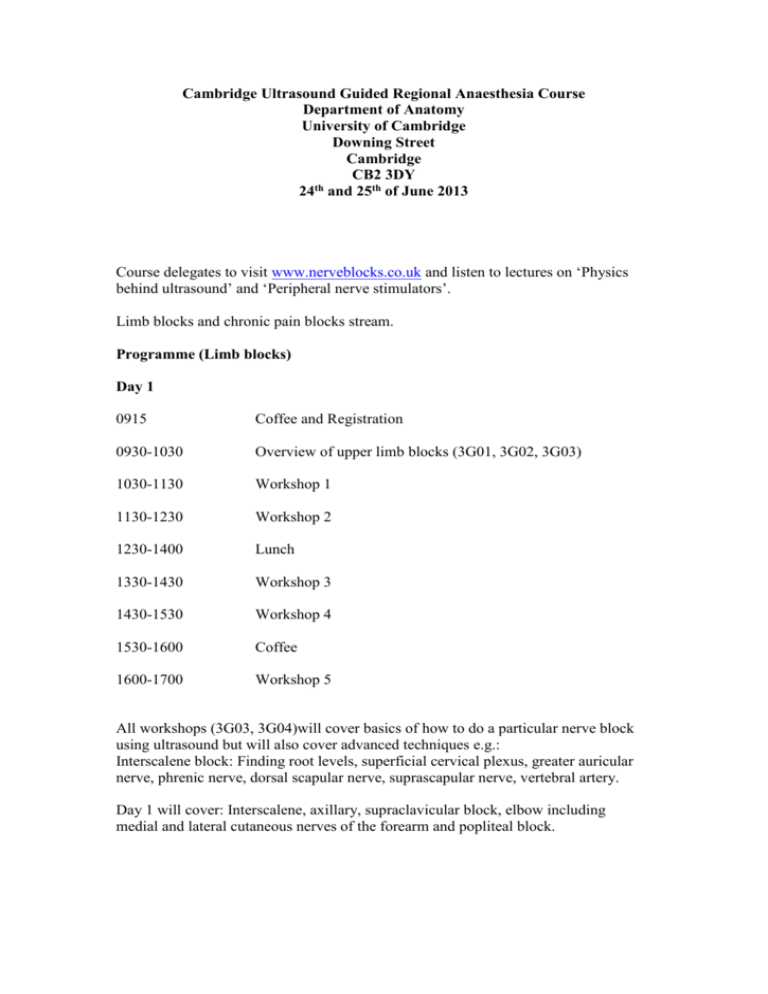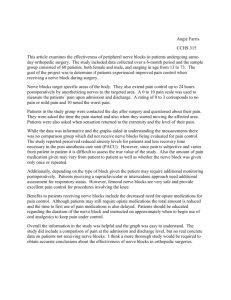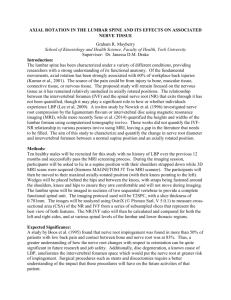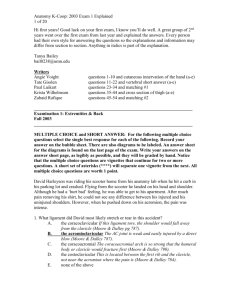Ultrasound Guided Regional Anaesthesia Course 2007, Cambridge
advertisement

Cambridge Ultrasound Guided Regional Anaesthesia Course Department of Anatomy University of Cambridge Downing Street Cambridge CB2 3DY 24th and 25th of June 2013 Course delegates to visit www.nerveblocks.co.uk and listen to lectures on ‘Physics behind ultrasound’ and ‘Peripheral nerve stimulators’. Limb blocks and chronic pain blocks stream. Programme (Limb blocks) Day 1 0915 Coffee and Registration 0930-1030 Overview of upper limb blocks (3G01, 3G02, 3G03) 1030-1130 Workshop 1 1130-1230 Workshop 2 1230-1400 Lunch 1330-1430 Workshop 3 1430-1530 Workshop 4 1530-1600 Coffee 1600-1700 Workshop 5 All workshops (3G03, 3G04)will cover basics of how to do a particular nerve block using ultrasound but will also cover advanced techniques e.g.: Interscalene block: Finding root levels, superficial cervical plexus, greater auricular nerve, phrenic nerve, dorsal scapular nerve, suprascapular nerve, vertebral artery. Day 1 will cover: Interscalene, axillary, supraclavicular block, elbow including medial and lateral cutaneous nerves of the forearm and popliteal block. Day 2 (limb blocks) 0900-1000 Overview of lower limb blocks. (3G01, 3G02, 3G03) 1000-1015 Coffee 1015-1115 Workshop 6 1115-1215 Workshop 7 1215-1315 Lunch 1315-1415 Workshop 8 1415-1515 Workshop 9 1515-1530 Coffee 1530-1630 Workshop 10 Day 2 workshops (3G03, 3G04) will cover Sciatic block (posterior/subgluteal/anterior approach), ankle block, Femoral, Tap and abdominal blocks and Epidural. On both the days delegates will have opportunity to practise needling techniques on phantoms. We will wherever applicable cover nerve stimulator guided techniques as well. Each workshop lasts for 60 minutes. The first ten minutes are dedicated to explaining the anatomy related to the nerve block using prosections (Total anatomy teaching time of 100 minutes over two days). The next ten minutes are used to explain the block technique. The remaining 40 minutes are dedicated for the delegates to have opportunity to scan the volunteers, ask questions to the faculty and brush up on their anatomy using prosections. There are four delegates per workshop. Chronic pain : Day 1: Workshop 1and 2 (morning session): Neck: Finding cervical roots, superficial cervical plexus, greater auricular nerve, phrenic nerve, dorsal scapular nerve, suprascapular nerve, vertebral artery, stellate ganglion block, greater occipital nerve, suprascapular nerve block. Workshop 3: Tap and abdominal blocks including ilioinguinal and iliohypogastric block Workshop 4&5: Lumbar epidural, lumbar facet, caudal and lumbar paravertebral block. Workshop : Day 2: Workshop 6 Supraclavicular block Workshop 7 Popliteal block Workshop 8: Axillary and elbow block Workshop 9: Femoral and lateral femoral cutaneous nerve block Workshop 10: Sciatic and ankle block










